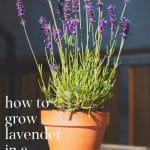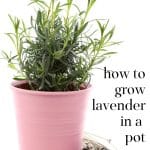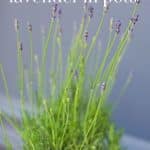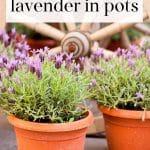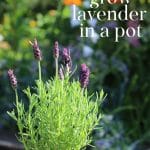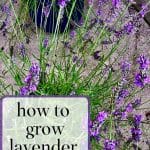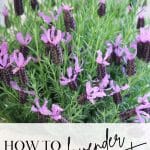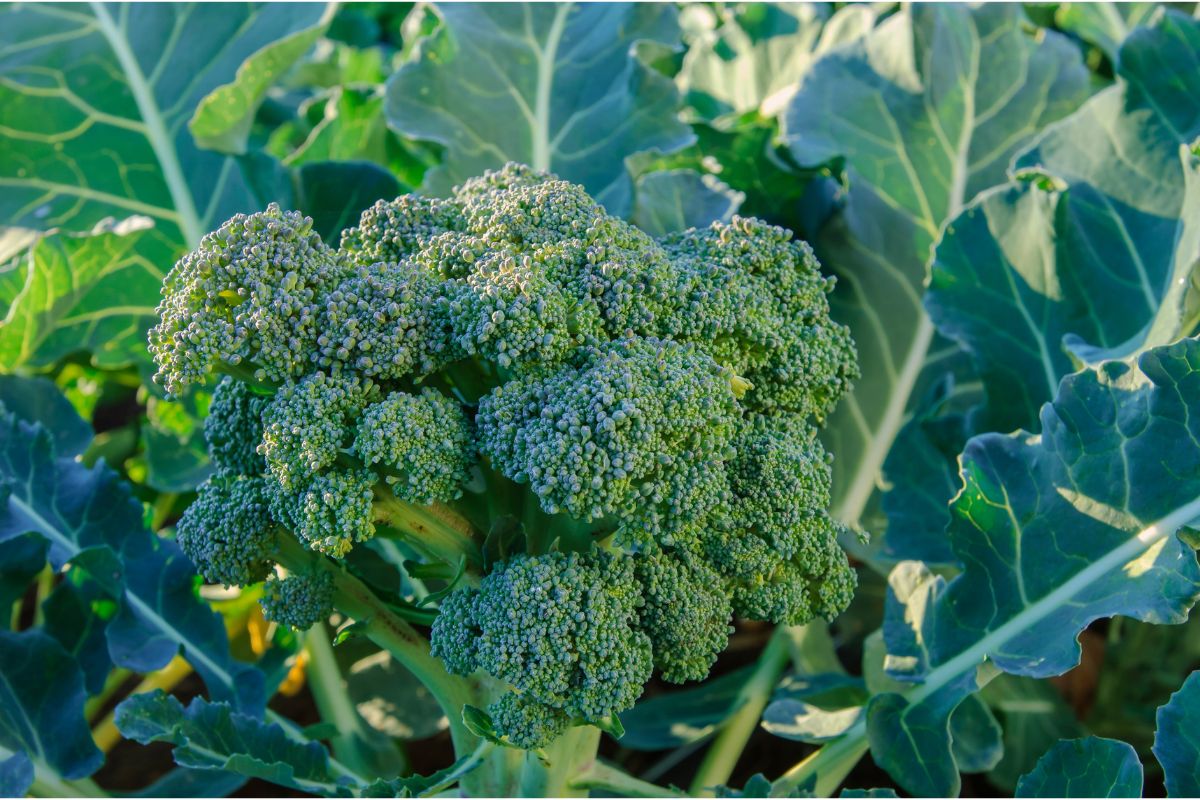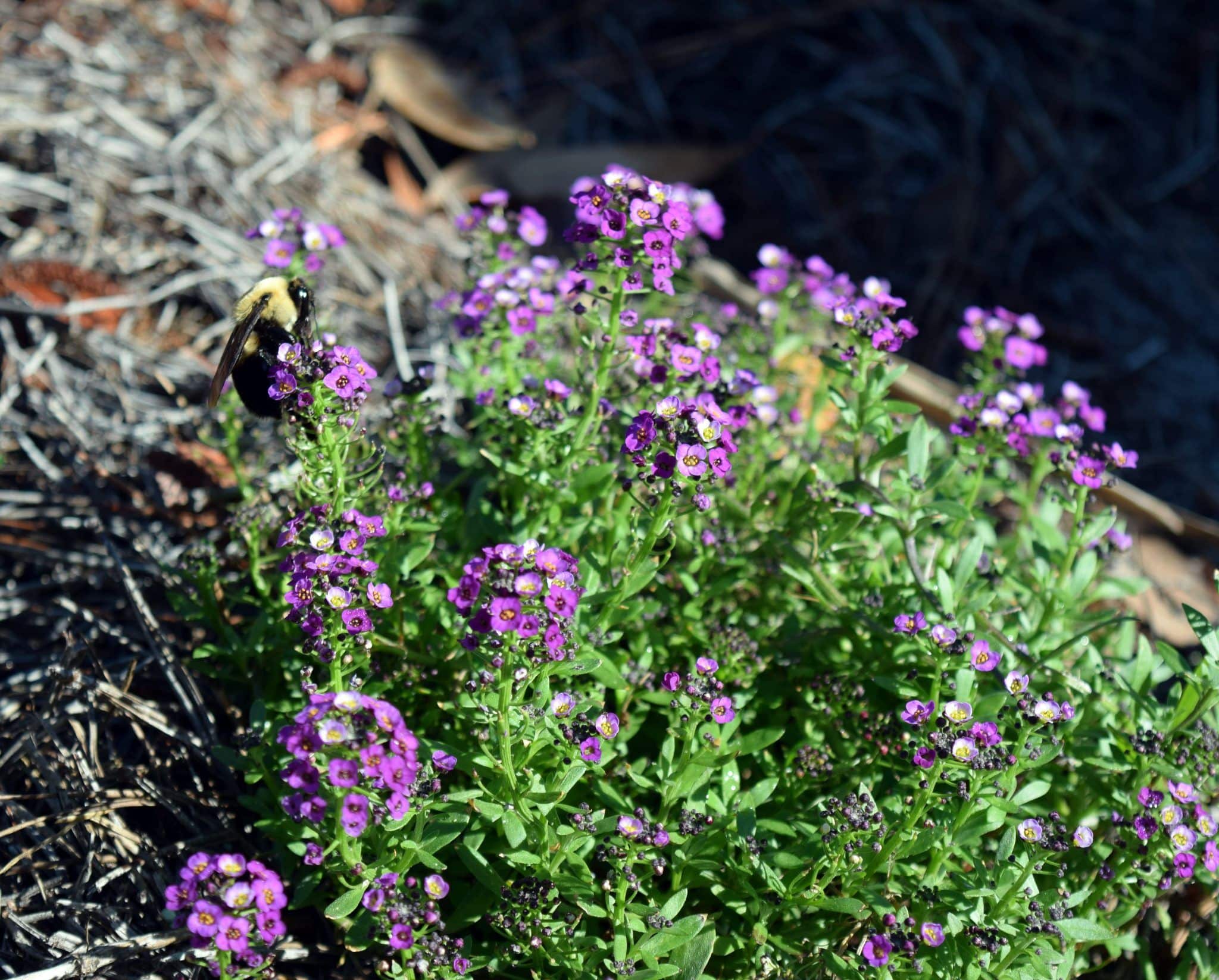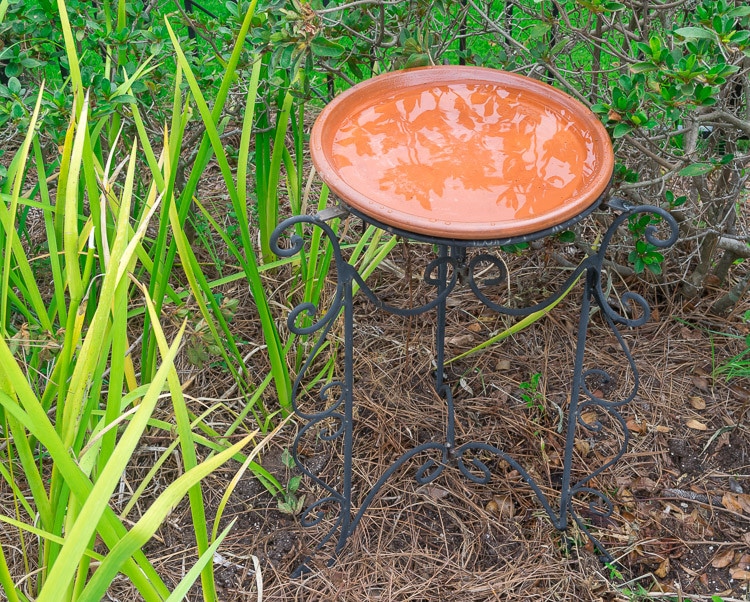Growing Lavender in Pots
Growing lavender in pots and containers is my preferred method of growing this fragrant herb. We will discuss varieties of lavender and the best conditions to grow thriving plants.
Are you looking for a versatile and functional plant to grow in your garden?
Look no further than the incredible lavender flower and the assortment of lavender varieties. Growing lavender in pots is a fantastic way to cultivate a plant you can use for various things around the house, from pest control to therapy to culinary creations!
Plus, it’s beginner-friendly for those with less experience in the world of at-home gardening.

Table of Contents
Lavender Fragrance has been Used for Centuries.
In ancient Rome, people used the essential oil from lavender plants to scent quality perfumes. Today, you can find lavender oil on the shelves of grocery and health stores. And every bath and body company- big or small- has an extensive collection of lavender-scented products, like bath salts, facial scrubs, lotions, and so much more.
What’s even better is that lavender cuttings are edible! With your organically grown lavender flowers, you will find hundreds of recipes for baked goods, like cookies, cakes, and ice creams.
Using Your Potted Lavender Plants
The uses for home-grown lavender are practically endless. Here are some excellent examples of how you can use your potted type of lavender:
- Therapeutic Uses: You probably know by now that lavender produces a relaxing fragrance used in all kinds of ways to calm pets and people alike. With your harvested lavender, you can create soaps, scrubs, oils, salves, and much more! I use lavender in my Herbal Bath Salts recipe.
- Culinary Uses: Perhaps you didn’t know that lavender is almost as versatile in the kitchen as it is for therapeutic uses. Make lavender vinegar, cakes, cookies, ice cream, tea, sorbet, and many other unique recipes with a floral twist. This Vanilla Tea Cakes with Lavender Glaze recipe is a perfect use for your lavender.
- Lavender Bouquets: Go the traditional route and harvest your lavender for stunning blue or purple bouquets. Keep them fresh and green, or dry the lavender. Either method makes for a strong fragrance and elegant display.
- Natural Pest Control: Lavender deters many pests. Keep fleas, moths, mosquitoes, and more away from you and your family by planting lavender in pots. Furthermore, lavender works incredibly well as a natural flea and tick repellant for your four-legged family members. Place some oil on their collar or bandana and watch the magic happen. I use lavender and cedar oil to repel clothing moths in our closets.
Choosing the Right Varieties of Lavender
Before you get started, choosing the right lavender plant is crucial to have the most successful planting in pots. All types of this plant will do well in pots and containers. However, some are known to be best for the method.
The following are perfect picks for growing lavender in pots:
English Lavenders

These varieties of lavender are cold and frost-resistant, making it an ideal lavender to grow outdoors all year. English lavender is more fragrant than other lavenders and works best for aroma therapy purposes.
- Hidcote
- Munstead
- Alba
- Jean Davis
French Lavenders

Unlike the English Lavenders, the French are less successful in cooler temperatures. Therefore, if your area experiences chilling winters, these species probably aren’t the smartest choice. If you’d like to grow them in colder climates, take your terracotta pots indoors when the temperatures drop.
French lavenders are characterized by their unique toothed leaves.
- Often called Dentata or Fringed Lavenders
- Riverina Thomas
- Ploughman’s Blue
- Pure Harmony
Spanish Lavenders

Spanish Lavenders are characterized by flowers that resemble pinecones with rabbit ears or pineapples. These lavenders do best in Zones 7-10 and don’t do well in colder climates. They bloom in May through June, and another quick bloom of flowers typically later in the summer, early fall.
- Strawberry Ruffles
- Silver Anouk
- Alba
- Kew Red
- Bandera Pink
Hybrid Lavenders
- Grosso – English and French hybrid with cold hardiness of an English Lavender and the fragrance and long-lasting flowers of a French Lavender. Hardy to US Zone 5 and able to withstand snow and frost. Blooms July and August
- Provence – Hybridy with strongly fragranced flowers and hardy from zones 5-10.
Lavandins
A naturally occurring hybrid between English and Portuguese lavenders that have a much stronger fragrance thrives in zones 5-9.
Supplies Needed for Growing Lavender in Pots
Besides your lavender sprouts or seeds, you’ll need the supplies below to grow these new sprouts of charming purple flowers:
- A pot or container with good drainage holes
- Small stones or clay pebbles
- Well-draining sandy soil or clay soil; cactus, succulent, and citrus soils work well for lavenders.
- Liquid fertilizer (optional)
- Other gardening supplies, like gloves and a trowel
How to Grow Lavender in Pots
Ready to produce some of the most beautiful, fragrant, and versatile flowers? Excellent choice– Let’s get started! Use the steps below as a guide to growing your lavender in pots.
Choose the Right Container and Soil
Choosing the right conditions for your new plant is essential. The lavender pot should be about 12 to 16 inches across with a proportional depth. This will give your plant plenty of space to grow healthy and abundantly. Additionally, you’ll want the pot or container to have a drainage hole at the bottom of the pot to avoid root rot and other drainage issues.
As for the soil, be sure you plant lavender in a well-draining potting mix with organic matter. Succulent or cactus soils work very well because of their sand and moss contents.
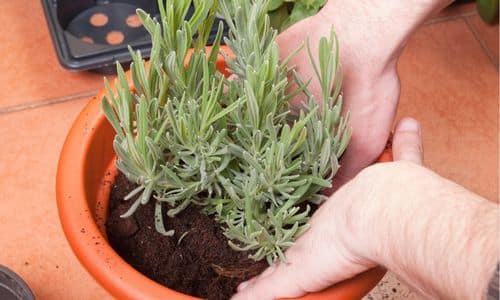
Pot Your Lavender Plants |
Before potting your lavender, it is wise to place stones or clay pebbles at the bottom and throughout the potting soil to aid drainage. Then, you’re ready for the next steps.
You have a couple of options for growing lavender in pots.
Starting with Seeds
If you choose to start from scratch using lavender seeds, ensure you purchase the freshest seeds you can find. Your local nursery may be the perfect location to find lavender seeds. Or you can search online for them.
Early spring is the best start time for growing lavender from seeds. Begin with small pots, one for each seed or a seed tray. Plant them using the correct potting dry soil and gently press the seeds into the top. Next, sprinkle a thin layer of potting soil on top and place your lavender plants in a full sun spot, like a sunny window or under a grow light.
In 12 to 20 days, you’ll see your new growth sprouting. Soon after, you can place them in large pots to grow tall and strong lavender stems.
Starting with Sprouts
It can be a challenge for some inexperienced gardeners to germinate seeds. If you are more of a beginner, purchase your lavender as sprouts to have the most success. Place your small lavender seedlings in the proper container and just enough soil by creating a planting hole in the dirt and lightly packing them in.
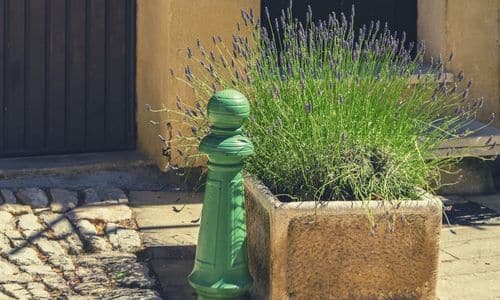
Place it in a Sunny Location
Lavender in pots needs ample sunlight. Ensure your plant is soaking up 6-10 hours of direct sunlight each day by placing them in the perfect location. If there isn’t an ideal spot for your plants to catch plenty of sunshine, you can move the container throughout the day. That’s what’s great about gardening in pots!
And your Lavender Pot will do best in an area with good air circulation.
Watering Your Potted Lavender
If planting seeds, water lavender plants daily to keep the soil moist. Otherwise, lavender plants need very little water, only about every 2 or 3 weeks in warmer climates. In particularly hot spells, you may need to give your lavender a bit more water; just watch it. You can water them a little less in colder weather.
Pro Tip: Balance is key. You don’t want the soil to become overly dry or too wet. So, pay close attention to your plants and use your best judgment while sticking to the recommended schedule.
Harvesting

Your lavender plants will be ready to harvest from late summer to early fall. Soon, you’ll be enjoying all the wonderful benefits of growing lavender in pots, from creating soaps and scrubs to cooking up some unique and delicious lavender recipes.
Cut your fresh lavender blooms with a sharp pair of sanitized gardening shears or scissors. To protect your plant, cut close to the bottom of the branches, about an inch from the soil.
Pro Tip: Suppose you plan on using your lavender for culinary purposes. In that case, do not use pesticides while growing your lavender.
Maintaining Your Lavender Plants
You’re well on your way to growing some stunning lavender plants! All that’s left is to maintain your plants by keeping up with a watering schedule and using the following tips and tricks for the most success.
Pruning
Each spring, it can be helpful to prune your potted lavender. Stick to pruning the top third of your plant, where the leaves and stems will regrow. Keep away from the base where older parts of the plant are found and will not grow again once pruned.
Overwintering Lavender Grown in Pots
You’ll want to bring your lavender pots indoors for the winter season in colder environments. Most lavender species will not survive the freeze. However, in warmer or more mild climates, you can keep them outdoors and place a layer of mulch on top of the soil for added protection from lower temperatures.
Fertilizing
Lavender doesn’t typically thrive with excess nitrogen from fertilizer. In fact, it can reduce the calming fragrance the plant produces and make it more susceptible to pests and disease. You will not need fertilizer if you have suitable soil for your lavender plant.
However, if you choose to use fertilizer, go with the organic products, and use minimal doses.
Diseases and Pests of Lavender Grown in Pots
Bacterial rot, leaf spot, crown rot, and root rot can affect your lavender in pots. Prevention proves to be the best method to protect your plant from these diseases. Ensure your pot is well-drained, has no air pockets in the root soil, and avoid overwatering. Regular watering is essential, but too much water is detrimental.
Furthermore, pests like aphids, thrips, and whiteflies are often found on lavender. Insecticidal soap and Neem oil can aid in keeping pests away. Otherwise, pick off these planet-destroying insects as soon as you see them.
All things considered, I find growing lavender in pots is easier than in the ground because you can better control the water and can bring it to shelter if needed.
Bookmark this page or pin the following image to return to this post on Growing Lavender in Pots in the future.
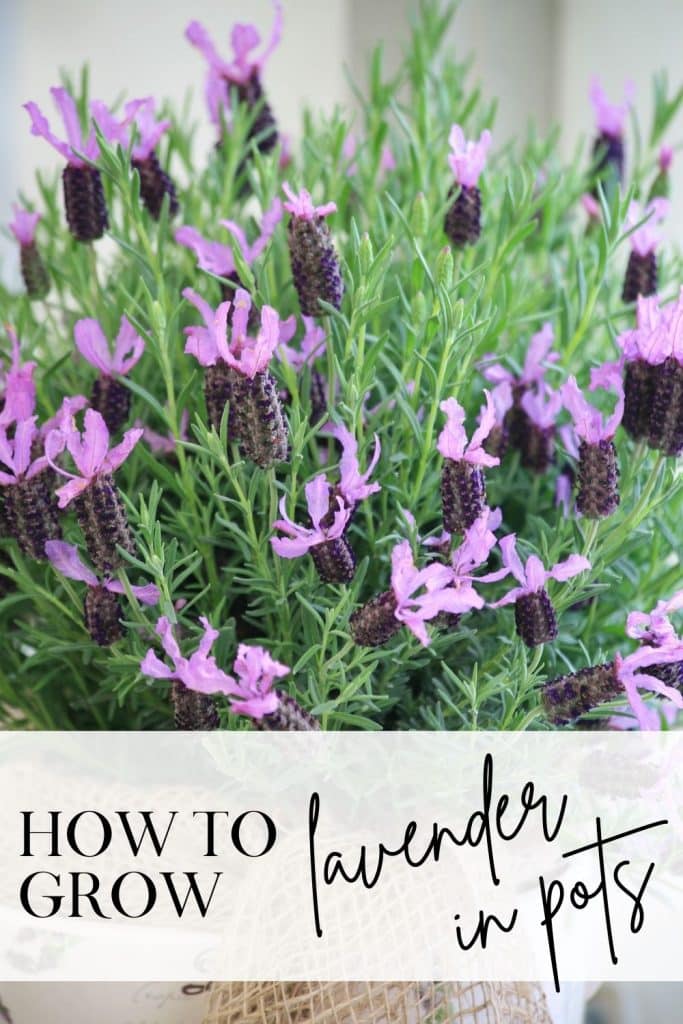
Thanks so much for spending a few minutes of your busy day with me!
To ensure you don’t miss future content, pop your email in the pale green box on the right or click here. I usually send one email weekly, so I won’t inundate your inbox. I’m sensitive to an overflowing email inbox!
We will only use your email address to send you emails, no more than 1-2 weekly. In addition, you will have access to my growing library of knit & crochet patterns and other printables. Check back often as this library will continue to grow. You can unsubscribe anytime by emailing me or clicking on the “unsubscribe” link at the bottom of all emails.
And you can access many of the products I refer to on my Nourish and Nestle Amazon Page. You can access it here.
So, if you’d like to participate in the ‘subscriber benefit’ action, simply subscribe to Nourish and Nestle here or use the form on the right sidebar. It’s slightly towards the top.
I have sent all my subscribers the link to the Subscriber Benefits Library. If you missed it or misplaced it, let me know.
Until next time…

